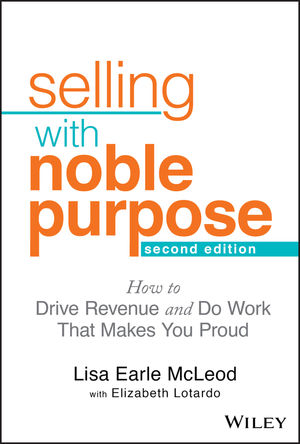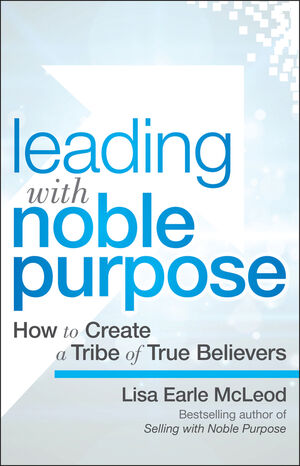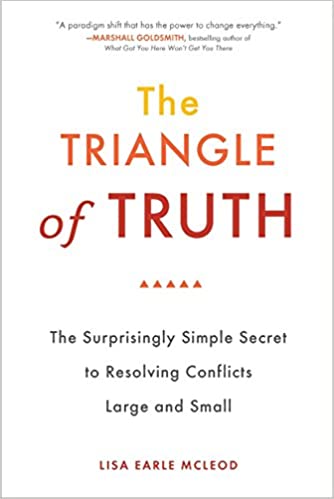

Lisa Earle McLeod is the author of Selling with Nobler Purpose ad has been named one of the top sales experts in the world. Her clients include LinkedIn, Hilton, and Roche along with numerous entrepreneur groups. She works as executive coach, consultant, and keynote speaker for leaders with ambitious goals.
Lisa has inspired 2 million plus learners on LinkedIn Learning and she is a regular contributor to Harvard Business Review. Her work has been featured in Forbes, Fortune and The New York Times.
Available For: Advising, Consulting, Influencing, Speaking
Travels From: Atlanta GA
Speaking Topics: Sales, Sales Leadership, Noble Purpose
| Lisa Earle McLeod | Points |
|---|---|
| Academic | 0 |
| Author | 290 |
| Influencer | 751 |
| Speaker | 33 |
| Entrepreneur | 20 |
| Total | 1094 |
Points based upon Thinkers360 patent-pending algorithm.
 How to Add Value in Big Meetings
How to Add Value in Big Meetings
Tags: Leadership, Sales, Business Strategy
 Moving the Goalposts: How to Be Proud of Where You Are AND Ambitious About Where You’re Going
Moving the Goalposts: How to Be Proud of Where You Are AND Ambitious About Where You’re Going
Tags: Leadership, Sales, Business Strategy
 Does Your Organization Trust You, or Track You? Employee Surveillance Gives Rise to a New Wave of Micromanagers
Does Your Organization Trust You, or Track You? Employee Surveillance Gives Rise to a New Wave of Micromanagers
Tags: Leadership, Sales, Business Strategy
 Re-Inspire Yourself with These 3 Mental Hacks
Re-Inspire Yourself with These 3 Mental Hacks
Tags: Leadership
 How to Tune out the Chaos When Working Remotely
How to Tune out the Chaos When Working Remotely
Tags: Leadership, Sales, Business Strategy
 How to Grow Your Career, Without Leaving Your Company
How to Grow Your Career, Without Leaving Your Company
Tags: Leadership, Sales, Business Strategy
 3 Signs You Should Ignore the "Feedback"
3 Signs You Should Ignore the "Feedback"
Tags: Management, Leadership, Sales
 3 Lessons Leadership Lessons I Learned from Working In Food Service (That Business School Never Taught Me)
3 Lessons Leadership Lessons I Learned from Working In Food Service (That Business School Never Taught Me)
Tags: Leadership, Sales
 Standing Out (When Everyone Is a High Performer)
Standing Out (When Everyone Is a High Performer)
Tags: Leadership, Sales, Business Strategy
 How High Performers Manage Their Boss
How High Performers Manage Their Boss
Tags: Management, Leadership, Sales
 How to Have A Better SKO
How to Have A Better SKO
Tags: Leadership, Sales, Business Strategy
 5 (Well-Intended) Sales Behaviors That Erode Your Business
5 (Well-Intended) Sales Behaviors That Erode Your Business
Tags: Leadership, Sales, Business Strategy
 What to Do When Someone Takes Credit for Your Work
What to Do When Someone Takes Credit for Your Work
Tags: Leadership, Sales, Business Strategy
 How to Say 'NO' To Taking on More Work
How to Say 'NO' To Taking on More Work
Tags: Leadership, Sales, Business Strategy
 How to Feel More Joy at Work
How to Feel More Joy at Work
Tags: Leadership, Sales, Business Strategy
 Re-Discover Your Potential with These 3 Mental Hacks
Re-Discover Your Potential with These 3 Mental Hacks
Tags: Leadership, Sales, Business Strategy
 Three Trending LinkedIn Phrases I’m Tired of Hearing
Three Trending LinkedIn Phrases I’m Tired of Hearing
Tags: Leadership, Sales, Business Strategy
 Bored at Work? It’s Costing You More than You Think
Bored at Work? It’s Costing You More than You Think
Tags: Leadership, Sales, Business Strategy
 The Hidden Time-Suck Holding You Back
The Hidden Time-Suck Holding You Back
Tags: Leadership, Sales, Business Strategy
 How High Performers Respond to Change
How High Performers Respond to Change
Tags: Leadership, Sales, Business Strategy
 Why We’re Weird about Self-Promotion (And How to Get Over It)
Why We’re Weird about Self-Promotion (And How to Get Over It)
Tags: Leadership, Sales, Business Strategy
 How to Give Feedback that Sticks
How to Give Feedback that Sticks
Tags: Leadership, Sales, Business Strategy
 What I Learned from 3 Days with The World's #1 Leadership Coach
What I Learned from 3 Days with The World's #1 Leadership Coach
Tags: Leadership, Sales, Business Strategy
 How to Make (And Keep) More Friends at Work
How to Make (And Keep) More Friends at Work
Tags: Leadership, Sales, Business Strategy
 Is Your Company Headed for Trouble? Here Are 3 Red Flags to Look For
Is Your Company Headed for Trouble? Here Are 3 Red Flags to Look For
Tags: Leadership, Sales, Business Strategy
 How to Deal with Your Imperfect Boss
How to Deal with Your Imperfect Boss
Tags: Business Strategy, Leadership, Sales
 Announcing Our New Book: Leading Yourself
Announcing Our New Book: Leading Yourself
Tags: Business Strategy, Leadership, Sales
 Leave the Party When You’re Still Having Fun
Leave the Party When You’re Still Having Fun
Tags: AI, Management, Marketing
 Get Your Hopes Up
Get Your Hopes Up
Tags: Management, Leadership, Sales
 4 Ways to Make Your (Normal) Job Easier with AI
4 Ways to Make Your (Normal) Job Easier with AI
Tags: AI, Management, Marketing
 Is Your Boss Holding You Back?
Is Your Boss Holding You Back?
Tags: Management, Sales, Business Strategy
 Selling with Noble Purpose - How to Drive Revenue and Do Work That Makes Your Proud
Selling with Noble Purpose - How to Drive Revenue and Do Work That Makes Your Proud
Tags: Business Strategy, Leadership, Sales
 Leading with Noble Purpose: How to Create a Tribe of True Believers
Leading with Noble Purpose: How to Create a Tribe of True Believers
Tags: Change Management, Leadership, Sales
 The Triangle of Truth: The Surprisingly Simple Secret to Resolving Conflicts Large and Small
The Triangle of Truth: The Surprisingly Simple Secret to Resolving Conflicts Large and Small
Tags: Project Management, Sales, AGI
 McLeod & More, Inc.
McLeod & More, Inc.
Tags: Leadership, Entrepreneurship, Sales

Tags: Leadership, Business Strategy

Tags: Leadership, Business Strategy

Tags: Leadership, Sales, Business Strategy
 Episode 107: How Can Leaders Avoid Burning Out?
Episode 107: How Can Leaders Avoid Burning Out?
Tags: Leadership, Sales, Business Strategy

Tags: Leadership, Sales, Business Strategy

Tags: Leadership, Sales, Business Strategy

Tags: Leadership, Sales, Business Strategy

Tags: Leadership, Sales, Business Strategy

Tags: Leadership, Sales, Business Strategy

Tags: Leadership, Sales, Business Strategy

Tags: Leadership, Sales, Business Strategy

Tags: Leadership, Sales, Business Strategy

Tags: Leadership, Sales, Business Strategy

Tags: Leadership, Sales, Business Strategy

Tags: Leadership, Sales, Business Strategy

Tags: Leadership, Sales, Business Strategy

Tags: Leadership, Sales, Business Strategy

Tags: Leadership, Sales, Business Strategy

Tags: Leadership, Sales, Business Strategy

Tags: Leadership, Sales, Business Strategy

Tags: Leadership, Sales, Business Strategy

Tags: Leadership, Sales, Business Strategy
 How to Know if Feedback is Worth Listening To
How to Know if Feedback is Worth Listening To
Tags: Management, Leadership, Sales
 How to Add Value in Big Meetings
How to Add Value in Big Meetings
Are you increasingly staying silent during big meetings, only unmuting yourself just to say, ‘Thanks everyone!’ as the meeting ends? Or, on the flip side- Do you find yourself trying to contribute only you wind up accidentally interrupting or overtalking others?
Meetings dynamics can be weird, especially over Zoom. Big meetings have a way of bringing back that awkward high school feeling of posturing, trying to be one of the cool kids. They can trigger our workplace insecurities.
Yet, big meetings are also a time that spotlights who is valuable to an organization, who has their finger on the pulse, and most importantly, who consistently delivers. If you’re not contributing, it shows. Don’t fool yourself into thinking people don’t notice.
Knowing when and how to contribute can feel like a tricky dance when you're not in charge of running the meeting. You want to talk, but you don’t want to dominate. You want to propel the discussion, but you also want the meeting to end on time. You want to show that you’re valuable to your boss, but not look like a show-off in front of your peers.
Here are three tips to help strike the balance:
Ask questions.
Meetings always benefit from someone asking the right questions. Think quality, not quantity here. Questions like: ‘What effect will this have on our customers? Who will be responsible for this? What's a reasonable timeline?’ move the meeting forward, adding insight and action. It's not your job to grill everyone or raise all the potential pitfalls, but simply to put forth an effort to ensure the meeting is comprehensive and actionable. Ask in a collaborative tone and then listen. And the more you listen, the better questions you will be able to ask.
Contribute in advance of the actual meeting.
If a big meeting is on your calendar, consider how you can contribute in advance. This doesn’t necessarily have to be asking for a formal spot on the agenda. Sometimes, that’s not feasible. Instead, get creative. You can forward a piece of topic-relevant research to the person running the meeting, or perhaps offer to support the meeting if the organizer needs someone to run breakout rooms, capture the next steps, or corral unanswered questions.
If you’re unsure how you could help, ask for the agenda before the meeting to jumpstart your thinking. What’s going to be covered? What are the ideal outcomes? Who else is attending? Side note- if the person who called the meeting can’t answer those questions, you’ll likely jumpstart some more thoughtful planning on their part (and the whole group will benefit from that).
Narrow in on action steps.
Early in my career, when I was trying to up my informal leadership game, I would always jump in quickly to speak up at meetings. Over time, I learned there is great value in speaking last. After a long meeting, it can be challenging to wrap up. To add value, you can offer a few themes from the meeting and report your own, or your team's, action items. Say something like, “For me the two biggest takeaways are, we need to prioritize x and Y.” If the meeting is very large, you can post this summary in the chat. Don’t be surprised if the organizer reads your comments aloud as a helpful summary (I say that as a meeting organizer, who has read aloud insightful chat comments a zillion times)
Not all meetings need to be a snooze fest. Even if you’re an informal leader, you have the opportunity to set the tone. If you're prepared, focused, and action-oriented, meetings can be hugely productive and leave you looking great.
Tags: HR, Leadership, Sales
 You See What You Look For: How to Train Your Brain for More Gratitude, Joy, and Connection
You See What You Look For: How to Train Your Brain for More Gratitude, Joy, and Connection
Have you ever decided to buy a certain type of car? Let’s say you want a blue sedan. As you mull over your decision, you notice blue sedans everywhere. Did everyone get a blue sedan overnight? Probably not.
When you become more aware of something, you start seeing it more often. This brain pattern can be annoying if you haven’t intentionally put some guardrails on your mind.
Fighting with your spouse about dirty clothes on the floor? If you walk into your bedroom and there’s a ‘not quite dirty sweatshirt’ randomly sitting on the floor, it will be all you see. Making a proactive effort to eat healthier? You may have never noticed the huge array of chips at your mother-in-law's house, but now it haunts you.
We (consciously or unconsciously) train our brains on what to look for and what to ignore. Our mental framework determines how much attention we pay to particular pieces of the world.
Think back to the hypothetical blue sedan. What if instead of being particularly conscious of blue sedans, you chose to be particularly conscious of moments of gratitude, joy, and connection?
When you make a proactive effort to notice these things, you’ll see more of them. For the rest of today, pick one of these categories to pay attention to:
Gratitude. I was working with an IT team at a major bank. We were talking about how they make a difference to their organization. One of the guys said, “No one ever notices us until something goes wrong.” It’s not just IT. It’s everything. Our brains gloss over all the times our takeout order is correct, all the days we wake up without a stuffy nose or every person who uses their turn signal on the road. Training your brain to notice how often things are going ‘right’ helps the rough patches feel more insignificant. Which statistically speaking, they are.
Joy. When do you feel the space between your eyebrows soften and the corners of your mouth lift up? Is it when you take that first sip of coffee, hear a throwback song, or take off your shoes at the end of the day? Pay attention to it. Notice the joy in other people. A child at the store, a dog being let off the leash in the dog park, or your team laughing at a cheesy joke on Zoom. After a few hours, the world will appear more joyful. It was always there, now you’re noticing it.
Connection. Did someone hold the door for you? Send you a funny meme? Even just give you a passing smile? These moments can be fleeting without a proactive effort to internalize them. You don’t need to spend minutes basking in the fact someone smiled at you; you’re likely way too busy for that. Just spend one second, as if you’re mentally checking off an item on your mental ‘to-do’ list.
This will feel awkward for the first couple of hours. Without an established lens, you’ll likely need to put forth some mental horsepower to tease out what you’re looking for. By the end of one day, it will become easier. You’ll start to naturally notice things in the moment they happen, instead of consciously reminding yourself to look.
We see what we look for. If you’re searching for evidence that your boss is a jerk, your spouse is rude, or your career is off track…you’ll find it. If you’re searching for things to be grateful for, small moments of joy, and opportunities for connection, you’ll find those, too.
Choose wisely, friend.
Tags: HR, Leadership, Sales
 Moving the Goalpost: How to Be Proud of Where You Are AND Ambitious About Where You’re Going
Moving the Goalpost: How to Be Proud of Where You Are AND Ambitious About Where You’re Going
You start out with I’ll be satisfied when I get that promotion. You get promoted, and then you think… I’ll be happy when I reach six figures. Now you make great money, but your mind jumps to, I’ll know I’ve made it when I have my own office.
Despite reaching all your (self-imposed) milestones, you still feel like you aren’t “there” yet. No matter how much you accomplish or how quickly you do it, your mind persists in constantly moving your own goalposts.
It’s a common qualm for high achievers.
If you’re a constant goalpost-mover (guilty) it can even happen before you reach the goal. When you’re close, and you’re pretty confident it’s going to happen, the once coveted thing is no longer the goal anymore. You’ve already set your sights on the next thing. The result is, you never pause to soak in how far you’ve come, costing yourself the intermittent pride, gratitude, and resolve that comes with achievement.
I’ve struggled with this for decades. Over time, I’ve learned that being proud of where you are and being ambitious about where you’re going aren’t mutually exclusive; the two can coexist (with some work).
Here’s what I’ve found helps:
Write down your goals.
Having the goal in writing makes it more concrete, which in turn makes the “I did it” feeling more real. Further, if you continuously write down your goals, you can look at your results over an extended period of time. Recent achievements often don’t feel as exciting; the work is still fresh, the challenges are still present, and the results are new. Yet if you look back at your goals from ten years ago, you’d likely swell with pride. You’re probably aware of how far you’ve come in the last year (it was a lot of work!) but it’s easy to lose sight of how far you’ve come in the last 10 years.
Mark the occasion.
When I first crossed the six-figure mark, I bought a $150 lamp I had been eyeing for months. The purchase felt a bit frivolous, but I bought it anyway to mark the occasion. Many years later, I still look at the lamp and smile. It’s a physical reminder of how far I’ve come. It doesn’t have to be buying something – take a trip or go out to a great meal and take a picture. Give yourself a reminder that you’ve ticked off an important goal. Otherwise, you’ll forget.
Define more significant goalposts.
If you’re changing your goal every week, you’ll exhaust yourself. The feeling of achievement will never be significant and new goals will cease to be exciting. If your job gives you weekly, monthly, or even quarterly goals, consider setting longer-term markers for yourself. Maybe it’s a promotion, a salary threshold, or even a work-life balance achievement, like being able to take Fridays off. The more substantial the goal, the greater feeling of achievement. But don’t wait until you’re making millions in passive income to celebrate; aim for something realistic in the next 6-12 months.
If you’re a high achiever, you’re probably accustomed to ‘congratulations’ and ‘good job.’ Your accomplishments are likely recognized at work, in your industry, and by your family. Yet until you learn to be proud of yourself, it will never feel real.
Never stop creating ambitious goals; that behavior got you to where you are! At the same time, grant yourself some praise. Recognize that your ability to celebrate (even for a moment) will give you the energy you need to keep going.
Tags: HR, Innovation, Sales
 How to Measure ‘Purpose’
How to Measure ‘Purpose’
People often ask, how do you measure noble purpose?
If you’re someone who has been managing traditional numbers for most of your career, expanding your field of vision can be challenging. Measuring something more abstract, like purpose, takes work. Consider this example from the (highly competitive) sport of figure skating.
The scoring in figure skating is more complex than scoring in speed skating or track. Figure skaters are scored on two elements. Part of the score is for technical merit and part of the score is for artistic impression.
If the scoring were simply based on technical merit alone, it would be a very boring event- one performer after another would do the same jumps and turns, checking the boxes for technical proficiency.
It’s the combination of technical merit and artistic impression that make the competition so compelling. The top performers excel in both. They check all the boxes for technical merit, but recognize, those are just the table stakes. No one wins gold on technical merit alone. The difference often comes down to the competitor’s passion and how emotionally engaged they are in the performance.
Business is the same. Yet in business, we often pretend that technical merit is the only thing that matters. But like figure skating, the technical merit (i.e. having a functioning product and adequate service) isn’t enough to win.
The challenge is, artistic impression is harder to measure. It’s the hundreds of little things that contribute to the customer experience. It’s the way your team pulls together after a mistake. It’s the tone of voice from your mid-level manager. It’s caring enough to call a difficult customer or coach a struggling employee.
It doesn’t fit nicely into a 1-5 rating, there’s not as much predictability, and it’s more difficult to be precise. Yet, we know, breakthrough organizations all have a special sauce. It’s palpable. And like a gold-winning figure skating performance, you know it when you see it. It’s qualitative. So how do you measure it?
When the ‘technical merit’ measurements become the sole focus, it dulls down your organization. Employees quickly recognize that these types of metrics have little impact on anyone except the people measuring them. Quantitative metrics are designed to improve compliance; qualitative metrics ignite commitment.
You cannot spreadsheet your way to a highly engaged, passionate workforce. It’s imperative to look beneath the numbers.
Tags: HR, Innovation, Sales
 “Kill the Competition” Is Not a Rallying Cry
“Kill the Competition” Is Not a Rallying Cry
During a recent product launch meeting at a high-profile SaaS company, the senior leadership team (attempted) to motivate their team using the all too familiar “kill the competition” rallying cry.
“We’re going to obliterate them!”
“We’re going to make those guys worry about their mortgages.”
The team was pumped. Mouths frothed. Fists were raised. They were poised to attack.
Yet, in the ensuing months, the team failed to meet their goals. They didn’t win much new business at all, in fact, they faced some major customer churn.
Focusing on beating the competition (rather than winning customers) is a common strategic error that often goes unnoticed in the heat of the moment. Yet over time, this mistake stymies growth, stifles innovation, and ultimately, erodes the success that leaders are trying to create.
An organization must stand for something; it can’t just be against someone else. When leaders focus on killing the competition, instead of adding value to customers, some challenging consequences emerge:
This troubling ‘kill the competition’ narrative emerges in the micro, with individual salespeople and small teams. It also happens in the macro, with the entire organization shifting its focus away from customers and obsessing over internal metrics and market share.
In an uncertain economy, competition can become fierce. With quickly developing technology, the race picks up speed. The organizations that “win” will be the ones that rise above the head-to-head, recognizing the ultimate end game is customer impact.
Tags: HR, Leadership, Sales
 Making Peace with a Good Enough Job
Making Peace with a Good Enough Job
Is your current job your dream job? If you’re like most people….probably not. Maybe there are parts of your job you don’t particularly enjoy, like granular reporting or clunky systems. Perhaps you actively dislike other elements, like an overbearing manager or inefficient coworkers.
When a job isn’t everything we want it to be, there’s a temptation to treat it like a stepping stone. Sometimes we view it as temporary. Or at worse, we hang our heads every day, feeling like we aren’t working up to our potential.
This morning, I heard about a new book coming out called The Good Enough Job: Reclaiming Life from Work.
I’ll confess, ‘good enough’ is the antithesis of my nature. That’s probably why I should read the book. This is the passage that first captured my attention:
From the moment we ask children what they want to “be” when they grow up, we exalt the dream job as if it were life’s ultimate objective. Many entangle their identities with their jobs, with predictable damage to happiness, wellbeing, and even professional success.
I’ve had career ambitions my entire life. For me, the constant drumbeat of the “next step” is ever-present pounding, beating into my head, decade after decade. Sadly, I’ve let ‘perfection’ be the enemy of ‘great’ many times, and in doing so cost myself peace and happiness in the process. The author continues-
Rather than treat work as a calling or a dream, (author) Simone Stolzoff asks what it would take to reframe work as a part of life rather than the entirety of our lives. What does it mean for a job to be good enough?
I don’t know precisely how to accept a job as ‘good enough’- the book doesn’t come out for another month. But the opening text sure got me thinking about why we should reclaim life from work.
Here are some reasons I’ve seen play out lately:
The sum of this shouldn’t be an invitation to keep your emotional cards close to your chest; you should still be all-in at work. But remember: A company will never love you back. My business partner Elizabeth just got back from maternity leave. She shared with me some advice she got upon her return – be where your feet are.
When you’re at work, be all in. And when you’re at home, be all in, too.
I get it; I’m Ms. Noble Purpose. I absolutely believe work should be a meaningful, challenging, and fun experience.
But it shouldn’t be everything.
Tags: HR, Leadership, Sales
 4 Ways to Make Your (Normal) Job Easier with AI
4 Ways to Make Your (Normal) Job Easier with AI
Are robots coming for your job? It’s tempting to think AI is reserved for the software developers and robotic engineers among us- and that “normal” jobs like ‘accountant’ or ‘sales rep’ are safeguarded against the rapidly evolving technological landscape. But in our hearts (and in our LinkedIn feeds) we see that’s not the case. AI is here to stay and the impact will be major.
It's not just Big Tech — employers across most industries are starting to see artificial intelligence have an impact on their business. In a survey of LinkedIn's Top Companies, nearly 70% said that AI is already helping them be faster and smarter. Another 32% said its impact is small now, but larger gains are expected in the next few years.
Don’t let that freak you out. In fact, you’re probably already using AI to make you more effective, and you don’t even know it. Spam filters, autocorrect, and predictive email text have become so integrated into our everyday work habits, we hardly even realize they’re there.
You don’t worry about a spam filter taking your job, right? You harness the tool to save time and energy, so you have more (human) brainpower to devote to your most important work.
According to George Anders, Senior Editor at Large for LinkedIn, “A lot of current AI excitement relates to rapid breakthroughs in large language models. These are the underpinnings of popular, widely accessible tools such as ChatGPT, which can spin up surprisingly plausible text answers to almost any question.”
Here are 4 ways to make your job easier with AI:
Brainstorm ideas. Do you ever ask someone for help, they give you a suggestion, and you immediately think ‘no, not that!’ But somehow, their terrible idea crystallized exactly what you should do. That’s me and ChatGPT. When ChatGPT gives me a bad idea, it makes the good ideas more obvious (and they come more rapidly). Next time you feel stuck, try asking ChatGPT for some ideas. Will you get something amazingly original? No. But it will jumpstart your unique thinking.
Enhance your writing. Flagging a basic typo is nice, but that’s the ‘floor’ of what AI can do for your writing. Want to appear more polished? Be more concise? Or strike a collaborative tone? You can, with a simple browser extension. I personally use Grammarly. Last week it pointed out to me that an email I was writing could’ve sounded friendlier…and it was right. (Thank you for saving me from my terse self.)
Summarize text. Have a mountain of material to review? Want to know the most important parts of the book your CEO is reading? Let AI pull out the most crucial bits of information. You can skip through any redundancies with a few clicks using a tool like Jasper. Better yet, you can use AI to provide a summary of a lengthy report you’re sending out. Trust me, your boss will thank you.
Do your homework. Will this dig up every piece of dirt on what your high school sweetheart has been up to? No… At least, not yet. But, if you have a meeting with a prospective customer, AI can help you prepare by uncovering the company’s history, identifying their competitors, and sourcing details about their customer base. Plus, unlike a chaotic foray of Google searches, the answers to your queries will appear on a nice and neat, easy-to-skim page.
Digging your heels into the sand and resisting technological tools never ends well…ask the sales reps still using phonebooks, or the accountant still using an abacus. Many have said, AI isn’t going to take over jobs, it’s going to take over tasks.
Leveraging these tools can make you even more effective at the uniquely human aspects of your role.
Tags: AI, HR, Sales
 Does Your Organization Trust You, or Track You? Employee Surveillance Gives Rise to a New Wave of Micromanagers
Does Your Organization Trust You, or Track You? Employee Surveillance Gives Rise to a New Wave of Micromanagers
Is the dot next to your name green or yellow?
How many emails did you send this week?
Did you swipe your badge, proving you went into the office today?
As it becomes increasingly easy to track our behavior (via our digital footprints) employers are capitalizing on the intel. According to HBR, In 2020, the global demand for employee monitoring software more than doubled. Online searches for “how to monitor employees working from home” increased by 1,705%, and sales for systems that track workers’ activity via desktop monitoring, keystroke tracking, video surveillance, GPS location tracking, and other digital tools are going through the roof.
As many organizations push a return to the office, that same hyper-monitoring is now being applied to badge swipes and parking passes.
Tracking employees, digitally or physically, is kind of like snooping through your spouse’s phone, no matter what you find, if you feel the need to do it, there’s a problem.
If you’re being tracked
If you’re doing the tracking
Finding out someone snooped through your phone makes you feel icky, even if you don’t have anything to hide. But here’s the thing: the snooper feels icky too. Nobody wants their behavior under a microscope, and most managers don’t want to peer through the lens, either.Employee surveillance tools could theoretically help organizations find themes, glean insights, and leverage data to become a better place to work. But sadly, I rarely see it play out like that. More often than not, hyper-surveillance undermines trust, sabotages engagement, and leaves all parties feeling the ick.
Tags: HR, Management, Sales
 Re-Inspire Yourself with These 3 Mental Hacks
Re-Inspire Yourself with These 3 Mental Hacks
You don’t need to change jobs, have an affair, or buy a Ferrari to get the pep back in your step. Yet sometimes, particularly when you’re seeing other people touting how excited they are about their dream job, we can fall into the trap of believing that our job should be exciting, fulfilling, and perfect all the time.
In reality, we all know that any long-term endeavor worth pursuing (marriage, exercise regimens, parenting, and yes, careers) requires us to put in extra mental effort, even when we don’t feel like it. But our annoying human brains crave stimulation and excitement; Too much sameness can zap our energy quickly.
Instead of seeking newness by leaving your spouse or quitting your job (and potentially derailing your life) try to reinspire yourself using these three hacks:
Start where it feels fun.
There are differing schools of thought on how to maximize productivity and tackle your to-do list- Do you do the hardest thing first? What about three small things, to get a quick win? Should you finish the thing you started yesterday or jump to something new?
Personally, I follow the advice I got from Meryl Streep’s husband (albeit indirectly). In an interview with Meryl, a reporter asked her, “Where do you begin when you’re learning a new character? The accent? The mannerisms? The lines?” She told the reporter, that she’d actually adopted a simple philosophy she learned from her husband, who is a sculptor: start where it feels fun (and easy).
Head smack, if it’s good enough for Meryl Streep, it’s good enough for me.
When you’re feeling down in the dumps, instead of looking at your to-do list based on strategic prioritization or urgency. Start where it feels fun! I’ve done this and recommended it to several overwhelmed execs. We’ll all find, the renewed mental energy you get from doing the fun part, enables you to get through the rest.
Don’t do all the heavy lifting alone.
If you’re feeling drained, reach out to your teammates or customers. Ask them what they’re excited about or what new ideas they have. Humans feed off each other's energy, and if you can’t muster up some enthusiasm for yourself, you can put yourself in an environment where you’re more likely to catch it from someone else.
The inverse of this is also true – and that’s where you need to be careful. The people you surround yourself with can refill your tank. They can also drain it dry. If you’re spending your entire lunch hour lamenting about how bad things are, or listening to others do it, that’s the reality you will eventually create (even if it didn’t start like that).
Make sure you’re not pouring from an empty cup.
If you’re tired, overworked, or not feeling well, the odds of re-inspiring yourself are low. I don’t say that to make you feel hopeless; sometimes all it takes is an adjustment of expectations. If you’re in a challenging season of life or work, I encourage you to release yourself from the expectation that your work is going to be as mentally captivating as it once was. That doesn’t mean it won’t be again, it’s just not right now, and that’s okay. Do your best, reach out for support, and know that the odds are, this too shall pass.
There will be times when the projects that previously filled you with energy bring on yawns, or the team you used to find fascinating now seems a little dull. It’s natural, but you’re not powerless. Having the skills to intentionally re-inspire yourself enables you to navigate the emotional ebbs and flows of a (most of the time) fulfilling career.
Tags: Coaching, HR, Sales
 How to Tune out the Chaos When Working Remotely
How to Tune out the Chaos When Working Remotely
I was about to get on an important client call. I’d done my research, gotten my coffee, and was ready with some thoughtful questions. Then I heard it… the leaf blower. It got progressively louder, as the landscaper walked closer and closer to my office window, revving up to a full roar, just as my Zoom meeting began.
At that moment, I found myself fuming at the well-intended landscapers, who were just trying to do their job; Landscapers that I hired, paid, and am immensely grateful for suddenly became the bane of my existence. Could they not read my mind that I was about to hop on an important call? But alas, they were as focused on their work as I was trying to be on mine. (Sidebar, if anyone wants to invent a silent leaf blower, consider me an investor).
Screaming kids, barking dogs, or the construction across the street can feel like a personal attack when you’re trying to work. Here are four tips to help:
Get noise-canceling software.
Having noise-canceling software you trust might not make it any easier to focus, but it will reduce your anxiety that others are hearing whatever chaos is on the other side of your laptop. Personally, I double up, using both Krisp and the auto-noise canceling feature on my iMac. I’ve virtually keynoted during a home renovation. Trust me, it works. Test it before you need it, so you have confidence when it’s show time.
Explain…and re-explain the work boundaries to your kid.
Growing up, my three younger siblings and I were less than quiet children. One evening, my mother was about to make a phone call and my father looked at us kids and said, “Your mother is about to get on the phone. Should I go ahead and send you to your rooms now, or wait until you interrupt her?” Because he knew, it was inevitable. Kids just know.
Spring break is upon us. If you’re working from home with children, you must define a workplace boundary. Kids do best with visual, physical boundaries, like a door. If having a door that defines your workspace isn’t feasible, literally tape out a square on the floor. And if you had a toddler, I’m sorry... Just try your best. Or, skip to the next tip.
Leave. Even if you just hide in your car.
Working from home usually just means you need WiFi and a laptop, no fancy office required. I can tell you from personal experience, if you park right out in front of your house, your car can be a quiet respite with a decent enough internet connection. I can also attest, that the Wi-Fi at most Best Buy’s reaches way out into to the parking lot. Thanks, Geek Squad. No more awkward Starbucks whisper Zoom meetings.
Remind yourself, it’s happened to everyone.
Trust me, you’re not the first person to have a work-from-home snafu. Just ask the guy whose kid interrupted his BBC interview (thank you for foreshadowing our future back in 2017) or the lawyer who couldn’t remove the Zoom ‘cat filter’ during virtual court. When it’s happening, sometimes it feels like time moves in slow motion, and that everyone is judging you immensely. They’re probably not. In some cases, it’s best to just explain what’s going on and deal with it as best you can. Chances are, they’ve been there too.
Tags: Coaching, Sales
 How to Grow Your Career, Without Leaving Your Company
How to Grow Your Career, Without Leaving Your Company
Much has been written about the need to change jobs every few years. Moving around keeps you learning, and more engaged, and is correlated with a higher income. Yet, moving around your health insurance, getting all new coworkers, and learning entirely new systems is a tall order. Constantly leaping can result in constant exhaustion. Plus, what about if you actually like your company? Should you hand in a resignation based on the assumption that your salary will benefit in the long term?
Increasingly more people are opting to stay, rather than job-hop, for a variety of reasons. Long tenures with an organization can be positive if you’re moving around internally. The new growth opportunities, stretch projects, and continuous learning keep the energy high while staying in a somewhat similar culture provides reassuring familiarity. Data from LinkedIn’s 2023 Workplace Learning Report shows that when employees make an internal move, they are 75% more likely to stay with the company at the two-year mark, a time when close to 50% of people are electing to leave.
Unsurprisingly, given the big pay-off (retention of top talent) the C-suite is now hyper-focused on mobilizing employees. Surveyed executives said ‘keeping employees motivated and engaged’ is a top priority. The second priority is giving employees opportunities to move into different roles within the business.
Internal moves can be the best of both worlds; Companies keep great talent and engaged employees grow their careers.
But if internal moves are so great…why aren’t more people making them? According to this year’s LinkedIn Learning Workplace Learning Report, only 15% of respondents say their organization encouraged them to move into a new role. While it’s true that many organizations are prioritizing giving employees opportunities to move into different roles in the business, there is a disconnect between what they’re saying and what they’re doing.
That’s not uncommon. Organizations tend to aspire to do things long before actually doing them (Sustainability, DE&I, living wages, the list goes on). So while the aspiration for internal mobility is there, the behavior lags behind.
If you’re a leader who can start the conversation, and internal mobility is something that’s possible for someone on your team, you should be the one to start the conversation.
I know, I know. You don’t want to lose a strong performer. I hear you. But I would suggest if you have a strong performer who wants to advance you’re going to lose them externally if you don’t find a way for them to advance internally. The question for all leaders is- would you rather lose your best people to a bigger job at this company, and have them see you as someone who helped their career flourish? Or would you rather they quit and go somewhere else, because they felt like you were holding them back? In most cases, one of those two things is inevitable. Your choice.
But even if your boss isn’t reading this and making the first move, you’re not powerless. If you want to advance without leaving here’s what you can do:
If you’re approaching that 2-year mark (or 20-year mark) and feeling the itch, you don’t need to pack up your desk and turn in your laptop just yet. An exciting opportunity might be a few doors (or zoom rooms) away.
Tags: Health and Wellness, Mobility, Sales
 What Feedback is Worth Listening to?
What Feedback is Worth Listening to?
Do you get you ever get unsolicited advice? Is your boss a nitpick on every little thing? Does your unemployed nosy neighbor know precisely why you aren't getting promoted? Some feedback is valuable, and other feedback is just a distraction.
Feedback overload is increasingly common. We’re asked to rate our service everywhere and leave reviews on every product. Performance conversations at work are becoming an even more frequent occurrence. We are hyper-assessing and often, being hyper-assessed.
It’s not entirely a bad thing. We can recognize and solve problems faster when evaluation is constant. Yet, when the volume of ‘feedback’ is immense, it usually comes with a lot of noise.
Filtering out the feedback worth listening to can be difficult. Here are three questions to help you decide if or when you should listen:
A lack of subject matter expertise will rarely keep someone from offering their opinion. Last week on LinkedIn Live my business partner Elizabeth described some bad advice she got many years ago:
In 12th grade when she was applying to college, she told the teacher helping her with applications that she wanted to double-major in education and television. At the time, Elizabeth was interning, teaching in a 5th-grade classroom and loving it. She was also doing several passion projects in film and tv, and immensely enjoying that creative outlet too. Why not combine them?
Her Language Arts teacher looked at her and said… “Well, those two things (education and television) don’t go together. There’s no overlap, they’re so different.” Had Elizabeth assumed that (likely) well-intended advice was accurate, she might have not pursued the combo that is now the centerpiece of her career.
We’ve since co-authored over 20 LinkedIn Learning courses, hello education and video. At this point, it’s obvious that the Language Arts teacher was incorrect. If someone shoots down your idea, consider the source- Does this person have knowledge about the landscape? If so lean in; If not, ignore it.
Early in my career, I was passed over for a promotion. It stung, but I stuffed my tears, and politely asked my boss, “What could I do differently?” He was struggling to articulate why I was passed over and why my colleague was promoted instead. Ultimately my boss landed on, “He (the guy who got the job) was just a better fit.”
To some degree, my boss was exactly right. The guy they promoted is still in that same job, almost 30 years later. Turns out he wasn’t just a good fit, he was a great fit. I think it’s also safe to assume that there were a few other things that made it easier for our boss to see my colleague as a leader than it was for him to see me.
Sometimes you get feedback (right or wrong) based on an undercurrent of something unsaid. Whether it’s cultural bias (which it likely was in my case) or the person simply has more industry knowledge than you, or they’ve seen this play out before. Looks for the rationale that is not being articulated, and let it inform your go-forward strategy. I left the company, but it could have gone the other way, it could have been a helpful counsel to change my behavior.
Ask yourself, Do you really want to get better at this? In a world of feedback overload, you’re going to have to pick and choose. You can’t be perfect at everything and trying to be is just going to run you into the ground.
If an expert speaking coach gives me some tough feedback on a keynote? I’m listening. No matter how hard it may be to hear. If Gordan Ramsey tells me my chicken is under-seasoned? He is probably right, but I don’t care. I’m never going to be a great cook and it’s not important to me to improve. My efforts are better spent elsewhere.
The noise of irrelevant or incorrect feedback can be distracting at best, and incredibly disheartening at worst. Before you let a bad review or disgruntled naysayer rain on your parade, ask yourself: Are they an expert? Is there something underneath this? And most importantly, Do I actually care?
Tags: HR, Sales
 How to Learn Faster
How to Learn Faster
Watch this webinar! Take this LinkedIn Learning course! What about certification? Are you up to speed on industry trends? These are the top 10 (or 10,000) skills you need to future-proof your career. Have you signed up yet?
The amount of learning available to us can be overwhelming. Especially when you need to do your day job on top of all this learning.
We know that high performers invest in their own learning. And, they also manage to get a lot done. These learners have maximized intentionality and efficiency to get the most out of the time they spend learning.
Here are three tips used by high performers to help you learn faster:
Look carefully at the descriptions of whatever learning opportunity you’re considering, and ask yourself: What will I be able to do differently as a result of this? We tend to get wooed by catchy titles and big-name speakers, but oftentimes, those don’t give the best learning ROI. To be clear, soft skills count. Your learning and development doesn’t need to sentence you to a life of excel training. Learning to be a better leader, a more clear communicator, and an expert time manager all matter. Not every development experience needs specific, buttoned-up learning goals, but when you’re pressed for time, look through the lens of skill improvement.
Taking notes with an eye to action (in addition to what you’re learning) makes application much more likely. After the program, course, or reading, choose 1-3 things you’re going to do (1 is the best) and schedule time for that. Learning is good, learning and applying is much better. For example, if you took a course on leadership and vowed to spend more time coaching, schedule the time. Every week. Without a place for our learning to ‘land,’ it likely falls into the (well-intended) back of our minds. Just another thing we should be doing… but aren’t.
Reflection time gives you the chance to process what was said at a deeper level. Yet, in the cadence of daily life, reflection time is the first thing to go. After all- you have stuff to do! I recently went to a four-day program for consultants. Everybody was rushing to catch the flight out, but I took the advice of a colleague who attended the previous year. She said, “if you can, stay over on the last night. Take the time to really think about how you’re going to apply these things, when you’ll apply them, what’s at stake if you get it right, and what you’ll cost yourself if you don’t do it.” That was contrary to my high-speed nature, but when I did it, I was shocked at how much more deeply I absorbed the content and how much more committed I was in applying it. It’s not always realistic to set aside a full day of reflection for each learning experience (this was a once-a-year chance for me). However, even a few minutes of reflection before racing to the next thing will maximize your investment.
Many years ago, ‘learning’ was a once-a-year event. You went to a conference or a training seminar for a few days, you got a workbook, and you devoted uninterrupted time to development. Now, learning (for better or worse) often happens in micro-moments. Whether it’s a quick search on how to do something on YouTube, skimming an article, or even taking a course, learning is much more integrated into our daily lives.
With a heightened level of intentionality, you can be a more efficient learner than ever before.
Tags: Innovation, Sales
 What Cartoonists Can Teach Us About Getting Buy-In
What Cartoonists Can Teach Us About Getting Buy-In
Have you ever had an idea you loved, and your boss immediately started poking holes in it? Or have you created a presentation and your colleagues responded with a list of things you should add?
As humans, we’re instinctively wired to want to point out flaws. Further, ambitious people are eager to put their mark on new developments. Everyone wants to play a part in something exciting.
In graphic design, they call this the ‘hair arms’ phenomenon. Here’s how it goes, according to Jessica Frease, a graphic designer:
“So the story goes that probably a long while ago - probably in the '30s or '40s - they had a lead animators, but they also had creative directors. And when the lead animators would make concept designs, meaning, like, character development, they'd be so proud of these characters. And they would go to their art directors, and their art directors would change something constantly even though they thought it was their best work.”
Sound familiar? You do great work and bring it to someone (usually your boss) who wants to put their own spin on things? Here’s where it gets interesting.
Frease continues, “So what they did was to distract the art directors from making other changes, they would automatically add hair on the arms of each character. Then, they would bring it into the big meeting with all the head honchos. And those guys would say oh, well, you've got to get rid of the hair on the arms. That's where the term ‘hairy arms’ comes from.”
Even though the animators knew having hair on the cartoon’s arms looked ridiculous, they added it anyway, because they wanted to give the big boss a way to change something, without taking away from the original vision for the character.
Should you try to manipulate your boss or peers by including proverbial ‘hairy arms’ in your work product? Not really. As tempting as it may be to intentionally misalign slides or include a glaringly obvious typo, this practice can cost you what might be valuable feedback. You want your boss’s brain, and the brains of your peers, working to provide a meaningful response (vs succumbing to a little trick).
Here are two tips to help you achieve both helpful feedback and get the buy-in you need:
Ask for feedback early. When you pour your blood, sweat, and tears into something and wait until it’s (in your view) 100% perfect, you’re setting yourself up for feedback that stings. Asking for feedback early in the process, when your own brain is more flexible, gives you room to pivot. Even if you don’t act on the feedback, engaging others early enables them to feel like they are part of the process rather than merely responding to the finished result.
Ask for specific feedback. Asking for feedback on an entire presentation, idea, or product leaves a wide-open door for critique that might not be helpful. Be clear about your ask. Is it the positioning of your opening remarks? The functionality of a key feature? The more clear and more direct you are about where you’d like feedback, the more valuable the feedback will become.
Making a specific ask will help your energy, too. You won’t feel like someone poked a bunch of holes in your entire project; they simply fulfilled your request for specific support.
This approach allows you to get the best of both worlds. Your boss or peers feel like they contributed because they did. And you still retain the ownership and pride in your work.
Tags: HR, Sales
 3 Leadership Lessons I Learned from Working in Food Service (That Business School Never Taught Me)
3 Leadership Lessons I Learned from Working in Food Service (That Business School Never Taught Me)
I’ve led teams large and small, and I’ve coached leaders in a huge variety of situations. The lessons I find myself drawing upon again and again, aren’t the things I learned in business school (Sorry, University of Georgia). They’re more frequently the timeless truths I learned earlier in my life, working in food service.
I never expected those first few jobs to teach me so much; I was just a kid who needed some extra money to get through school. But what we learn early in our careers is often foundational, leaving lasting impressions on us. Here are three lessons that stuck with me.
Never underestimate how much success means to your boss.
My first job was working at Donut King. I was 14 and worked behind the counter. Usually, the owner was there, but one afternoon, he stepped out to run an errand and left me to hold down the shop.
A few minutes after he departed, a large group of 20 or so firefighters came in. It was towards the end of the day and the firefighters bought every single donut we had left in the case, over 200 donuts. We had never run out of donuts before, I didn’t know what to do. I offered to go into the back and see if we had more. We did and they bought those as well, for a total of 225 donuts. (I still remember the number)
When the owner came back, I told him, “All these firefighters came in and bought every donut we had in the store!” He was elated. Absolutely beaming, he asked me if they liked them, if I thought they would come back, and thanked me for serving all of them. To me, this was a summer job to earn some extra cash, and the firefighters were just an interesting experience. To the owner, this was his life’s work, and something he was extraordinarily proud of.
In business, if we’re not feeling “into it” we assume others feel the same. That’s seldom the case. Even if a job is a stepping stone to you, it might mean everything to your boss, the founder, or the customers.
Emotional acting will erode your spirit…quickly.
Emotional acting is a phrase coined by Wharton professor Adam Grant. It’s when you put on a persona and you fake it, in a lot of interactions, all day long. Anyone who has worked in a restaurant, retail store, or any type of customer service capacity knows this feeling deep in their soul.
In college, I worked at a swanky cocktail lounge. Every night I would fake laugh at stupid (or gross) jokes, ignore degrading remarks, and pretend like an overpriced gin and tonic was the most delectable beverage on earth.
Emotional acting is physically, intellectually, and emotionally draining. To be clear, we all have times when we should be carefully managing our emotions, like calming ourselves after some negative feedback or trying to have a good attitude in the face of a disruptive change. But repeatedly masking our emotions at work is exhausting and it’s not sustainable. Innovation, creativity, and engagement depend on showing up as your authentic self.
A lack of clear expectations is at the root of (most) performance problems.
Later in college, I got a new waitressing job at a full-service restaurant. In the haze of onboarding, someone probably told me, when you’re not busy with tables, you should be rolling silverware. Between learning the menu, the table numbers, and the new system, I forgot.
Until three weeks in, when a more experienced waitress lost it on me. “You think you’re too good to roll silverware like the rest of us!! I haven’t seen you bring a single batch to the host stand!”
I was stunned. I didn’t think I was too good to roll silverware, good grief, I was a waitress, nothing was beneath me! I literally just forgot that single passing comment. I didn’t know rolling silverware was an expectation. Rest assured, I started rolling, but the dynamic remained awkward from that point forward.
I’ve witnessed the same dynamic play out on teams I lead and inside of my clients. When expectations aren’t clear, and repeatedly referenced, performance becomes personal very quickly. The vast majority of people want to do a good job, and with clear expectations, will rise to the occasion.
Tags: Leadership, Sales
 Is Your Boss Holding You Back?
Is Your Boss Holding You Back?
If you want to get promoted, grow your career, or even make a bigger impact in your current role, your boss will play a crucial part in either propelling that future or holding it back.
Even well-intended managers can fail to recognize the potential of their employees; in the cadence of daily business, boss-employee relationships tend to become more about deliverables than strategic growth.
Feeling like your career is motionless is frustrating and without the encouragement of your boss, it’s easy to lose your own motivation. Here are three signs your boss may be holding you back:
They ‘yes/no’ opportunities on your behalf.
Part of being a strategic manager is knowing how to best allocate the time and resources of your team. However, if your boss is repeatedly declining opportunities for you to take on stretch projects, contribute to new initiatives, and have professional development experiences, you should start to raise an eyebrow.
Several years ago, one of my clients was exploring offering an educational-reimbursement benefit. The program would help offset the cost of MBAs for qualifying employees. When the Chief People Officer approached the Chief Revenue Officer about the idea, the CRO shrugged and said he didn’t think his team would be interested in that. After all, they’re busy, and in sales, an MBA typically isn’t a requirement for growth. A year or so later, one of his top reps left the organization, citing a lack of professional development opportunities. He went to work for an organization that was willing to pay for his graduate degree.
In that scenario, there’s some fault on both sides. The CRO said his team probably wasn’t interested (and he shouldn’t have, without asking). Yet, the rep never expressed his desire for professional development. You can avoid this trap by recognizing (and even asking) for specific growth opportunities. When your manager undoubtedly knows you’re interested, they’re more likely to put your forth.
They’re not moving either.
Not all bosses want to move up or on to new opportunities. That’s certainly not a requirement for being a manager that champions the growth of your team. However, when career growth isn’t in their personal sightline, it’s easier for it to fall off their radar completely (and their team ends up paying the price.)
If your boss has been in their role for a long time or is perhaps, counting down their years until retirement, it’s imperative that you be absolutely transparent about your own desire to grow.
They’d describe you as irreplaceable.
At first, this seems like a compliment. In fact, it likely is a compliment. Yet, being irreplaceable (which means you’re irreplaceable) is a double edge sword- you’re valuable, but you can’t move. There is some nuance here; being ‘irreplaceable’ in terms of strategic thinking, perspective, or trust is very different from being ‘irreplaceable’ because, you’re the only one who knows how to use the software.
If your boss starts to tell you how they could never live without you, dig into why that is. Is it because you have the skills essential for this role? Or the insights and vision necessary for the future?
None of these signs alone are the kiss of career doom, but taken together, they can contribute to a rather stagnant picture. If you’re feeling like your boss might be holding you back, you’re not powerless.
Be transparent about your desire to accelerate your career and ask for their support. In most cases, your boss will be more than willing to champion your growth. But you won’t know if you don’t ask.
Tags: Leadership, Sales
 Standing Out (When Everyone is a High Performer)
Standing Out (When Everyone is a High Performer)
Last month I was talking to a friend who teaches an undergraduate course at Harvard. He shared an interesting phenomenon: When someone is accepted into Harvard, they’re typically at the top of their class. Compared to their high school peers, they had better grades, more extra circulars, and higher scores on the SAT.
Then. . .
They arrive at Harvard. Suddenly, they’re not the smartest student in class anymore. Everyone has the exact same (or better) achievements as they do. Overnight, they go from being a standout to being one of the indistinguishable masses, blending in just like every other member of the Freshman class.
It’s a disruption that can be absolutely jarring to high performers. The same thing happens at work. When you make it to the top of your field- whether that’s getting a job at the top firm, being awarded a certain distinction, or making it to the C-Suite, you go from a star player to just another member of the team.
The praise, recognition, and achievement you got used to as a top performer are in short supply at the top because everyone you’re with did the same thing as you. That’s why they’re there. But nevertheless, you must forge your path, and it starts with trying to stand out in an increasingly noteworthy pool of talent.
Here are three tips to help:
Recognize, sheer work output probably won’t cut it. There will always be someone who is getting more done. If you’ve risen to the top by working through weekends, taking late-night meetings, and producing an exceptional volume of work, your pace is likely not sustainable. You’ll need to find a new differentiator (if you ever want to sleep again).
Focus on maximizing your strengths. You’re better off working to further improve your strengths, rather than trying to “fix” your weaknesses. Strengths-based leadership scholars, Robert Kaiser and Darren Overfield say, “The deficiency model is inefficient and ineffective because fixing weaknesses might get a manager to improve from “poor” to “average” but will never make that manager outstanding” because the only way to achieve greatness is to maximize one’s innate gifts.” For example, if you’re a raging extrovert (like me), you’re better off improving your already strong ability to connect with people. If you’re an introvert like my husband, work on your ability to think strategically and listen to several points of view. An overwhelming inability to manage your time or resistance to feedback will hinder anyone, but if you’ve already risen to the top, any weaknesses you have are likely not diabolical.
Resist the urge to make everything a competition. In this environment, it’s tempting to become hyper-competitive with your peers. It’s a mistake many ambitious people, myself included, are guilty of. Last year, I wrote about why your peers are your allies, not your competition. Sure, maybe only one of you will get promoted at the end of this year, but each of you will build impactful, fulfilling careers, and next year the roles may be reversed. Stay in touch, cheer for each other, and know that the world is smaller than you think.
Rising to the top of your field is an incredible feeling. Staying there (or going higher) will require a different level of intentionality, strategic thinking, and relationships. As my long-time mentor Marshall Goldsmith says- what got you here won’t get you there.
When you feel a sting of competitiveness or imposter syndrome, take it as a cue to reevaluate how you can bring the best version of yourself to the next level.
Tags: Innovation, Management
 How High Performers Manage Their Boss
How High Performers Manage Their Boss
Whether you have a great boss, a terrible boss, or a well-intended (but overwhelmed) boss, the relationship you have with your boss has a major impact on your career trajectory.
I’ve coached many leaders who have good relationships with some of their direct reports and challenging relationships with others. The boss is the same, yet their relationships with their direct reports varies, sometimes wildly. Often times, the difference is rooted in the intentionality and thoughtfulness of their subordinates.
Here are four best practices high performers embody to create successful working relationships with their boss:
Boss management isn't about manipulating your boss or trying to puppeteer the situation; it's authentically bringing strategic thinking, support, and empathy to one of your most important working relationships.
Tags: Leadership, Management
 How to Have A Better SKO
How to Have A Better SKO
“This could have been an email”
It’s the ultimate critique of a meeting. It’s bad enough when someone says it, or more likely, texts it to their colleague during a routine presentation. But it’s worse when it happens at an important event like your annual Sales Kick Off (SKO).
Imagine blocking out calendar days, working on the content for weeks, sending out perfectly curated swag, and (if you’re in person) spending money on hotels, airfare, meals, etc. Only to have your team sit through a bunch of Power Points while they think, “This should have been an email.”
First quarter is (historically) when millions of salespeople leave their families, their homes and their customers; to get on a plane, and gather in a hotel ballroom to listen to what has traditionally been a 1-way monologue of detailed financial results and product specs. Tack on all the lost sales time, and it’s a recipe for a wasteful (and very unemotionally engaging) experience. For all parties involved.
This year, whether you’re meeting in person, or virtually, the expectations have changed. People will no longer tolerate boring, one-way meetings. End of story.
If the meeting content is nothing but back-to-back PowerPoints (or worse, a verbal beatdown on quota) it’s worse than just a lost opportunity to engage. Those old school style meetings have a detrimental impact on team engagement. What makes it even worse for sales teams, is that this lack of enthusiasm spills over onto customers. It’s a recipe for a downward spiral.
It doesn’t have to be this way.
As someone who has delivered keynotes and training for (literally) hundreds of sales meetings, I’ve seen the difference between a meeting that inspires, and those that are boring, or even worse, demotivating. I’ve watched teams walk away on fire. I’ve also (sadly) watched ballrooms (and Zoom rooms) full of salespeople secretly wondering “When is this going to be over?” as the CEO drones on about EBITDA.
Whether you’re the CRO leading the meeting, a planner pulling the meeting together, or a sales manager/rep attending the meeting, you can and should make the most of your SKO (Sales Kick Off) by being intentional. Here’s what the top tier does differently to make the most of an SKO:
Senior Leadership: Prioritize emotional engagement over financial reporting
Treat your SKO as a culture building event, not a report-out. Instead of treating the events like an investor calls or board meetings, where “customers” are discussed as an abstraction and the conversation is all about internal metrics, flip your story.
Instead, consider this powerful reframe that Mike Gianoni, the CEO of Blackbaud, used to transform their business.
When Gianoni took over as President and CEO, Blackbaud’s stock price was declining and their earnings were flat. Most CEO’s would have jumped in to rally their team around increasing revenue. Gianoni chose a different focus. Despite the stock market pressure every CEO feels, Gianoni didn’t lead with numbers, instead he started talking about Blackbaud’s customers. Not just who they were, but also what they did, and the impact Blackbaud could have on their organizations.
Gianoni describes the way Blackbaud had traditionally run their meeting. “When I first started with the company, people would get up on the stage, and spend most of the time on financials.” Gianoni flipped it. He says, “Now I only spend 5 minutes on the financials.” The new format, is, “What’s our purpose, how does it impact customers, and are we doing OK financially?”
We worked with Blackbaud’s leader team to shift the organizational narrative from a money story to a meaning story. (In our LinkedIn Learning course, How to Motivate Your Sales Teams, we share techniques for making the most of your leadership air time).
As Gianoni reflects on the turnaround he orchestrated, driving record growth for Blackbaud, he says, “It’s more important to have our associates understand why we get up and go to work each day. At the end of the day if you have a healthy culture, focused on customers’ success, and the right leaders with the right level of integrity focused on customers, and a culture willing to make decisions, the financials fall into place. The financials are at the bottom of that, not at the top of that. That’s how companies actually work, that’s why we do our town halls that way.”
You can elevate the conversation in your meetings by telling customer impact stories. These are specific stories about how your solutions make a difference to the individual real live human beings who buy from you. You can even take it one step further. Blackbaud makes a regular practice of bringing in customer to discuss how their solution impacts their business, and the lives of the customer’s customers.
Telling and hearing these customer specific stories enables your sales team to understand with great clarity who your best customers are and how you help them. That clarity becomes a crucial part of their sales narrative through the year.
Consider this tip from fellow LinkedIn Sales [In]sider Robert Knop:
“Ignore the age-old thinking that you need to cast the biggest net possible. That approach creates a shallow relationship with prospects and clients. Instead, of wide and shallow, think narrow and deep.” Talking about individual customers creates more emotionally affinity. It also shows salespeople what an ideal customer looks like. Knop suggests, “Trim your group of prospects to a size where you can follow them, do research on them, personalize and customize your approach. You will have less leads, but more closes.”
Sales Managers: Schedule time for your team to apply the content
Whether you have inspirational keynotes, learning sessions, or exciting product updates, top performing sales managers maximize this experience by bookending the event with some intentional application time with their team. Before SKO begins, talk to your team about what they want to get out of the experience. It helps to think of your SKO as an enablement event: What do you want your team to think? Feel? And do as the result of this time? Start the “What’s going to be different after this meeting” conversation about before the event descends into “free drinks, fun time.” Fun matters, so does connection, and so learning.
Reflecting on what you want to think feel and do as a result of the meeting helps you find creative ways to leverage any flex time with your team to its maximum potential. There is likely (hopefully) great intentionality around large group experiences, like opening keynotes and evening events. Leverage the in between time to ensure your team is getting the meeting experience they need.
Consider this tip from fellow LinkedIn Sales [In]sider Lee Hacohen:
“If you’re in a virtual space “Mirror activities you would traditionally do in-person, especially break-out workshops and team building activities. Use the platform’s break out rooms, virtual white boards, emojis and other engagement apps.”
As a sales manager, your intentionality shouldn’t end after the event wraps. Post SKO you can conduct a robust debrief. An exceptional debrief strategy I’ve seen from top sales managers is to assign each person on their team one session from SKO to debrief with the larger group. For example, if one person is responsible for facilitating the debrief on the CROs opening remarks, they could ask: What does it mean for the team? What are the next steps? What was exciting, surprising, or confusing?
If the next person on the team is responsible for debriefing the opening keynote, they can share: What were the big themes? How can the team apply what they’ve learned?
You don’t need to cram your debrief into the ride to the airport, nor should you. Spreading this debrief out over the following weeks makes it even more effective.
Sales Reps: Be fully present for learning and connection
I started my career as a sales rep for a major consumer products company. I remember going to our annual sales meetings, excited and with the best of intentions. Yet after two days of strategy overview and rah rah, I often found myself walking away saying, “Well that was fun, but what do I do differently on Monday morning?” Yes, your SKO is absolutely a time for fun. It’s also a time for learning and connection.
If you’re a sales rep, no matter what the content of the meeting, you can create meaningful connections. Consider this suggestion from fellow LinkedIn Sales [In]sider Samantha McKenna:
“Block that time as dedicated time with your teammates, not with your clients. Yes, we feel important when we leave the room for calls. Yes, we love the feeling of moving deals along. As a top performer, I know urgency all too well. But, blocking that time to truly invest in your peers, your leaders, and the content that’s being delivered will pay off in spades.”
It’s easier said than done (especially when your inbox awaits). Yet, this is likely one of few opportunities you’ll have to spend uninterrupted time investing in your future. Time you spend with your leaders improves your organizational reputation, time you spend learning improves your selling ability in the long term, and time you spend with your peers improves your bond as a team (and your work experience). Approach your SKO by playing the long game. Don’t sacrifice next year’s promotion, performance, or peer relationships for the sake of responding immediately to emails.
Whether you’re the CRO or an entry-level BDR, your Sales Kick Off is an opportunity to bring connection and a greater sense of purpose to life. A rehash of the financials in a darkened room while salespeople are darting in and out to take calls isn’t worth getting on an airplane for. Instead, challenge yourself and your team to create an emotionally engaging event that will fuel you for the year ahead.
Tags: Future of Work, Sales
 5 (Well-Intended) Sales Behaviors That Erode Your Business
5 (Well-Intended) Sales Behaviors That Erode Your Business
I’ve long said: Sales makes the wheels of commerce spin. Whether you’re a solopreneur or leading a multinational team, the ability to sell keeps your business moving. As we enter (what seems to be) a period of economic uncertainty, organizational leaders and salespeople become anxious about keeping revenue flowing. This can prompt poor sales behavior that actually erodes business.
In times of fear, our best intentions often fall by the wayside. Intellectually, we know that successful relationships are built by listening, focusing on the customer, and adding value. Yet, when we’re behind on our number, it can be difficult to tamper that grabby please buy from me energy.
Here are five sales behaviors that will sabotage your growth:
Spray and pray. A salesperson sprays their pitch out there (talking endlessly about themselves to anyone who will answer an email) and prays that something sticks. If you’ve ever gotten a cold call (or email) about a product or service completely irrelevant to you, you’ve been the victim of the spray and pray. In the moment, it’s annoying and usually won’t get a response. Over time, it weakens the reputation of an organization.
No pre-call planning. This tends to go hand-in-hand with the spray and pray. A lack of pre-call planning is obvious when a salesperson shows up and their first question is “tell me about your business.” As a business owner with a robust website and digital history, this question irks me like no other. When you’re busy, pre-call planning can fall by the wayside. It’s not always obvious at first, because most people are polite at the moment, but it does impair the close rate later.
Selling to tricky comp plans. Incentivizing a sales team to sell a certain product or solution isn’t uncommon nor is it inherently bad. The challenge comes when the incentive overrides the emphasis on deep client discovery and the intent to sell people things that actually improve their life or business. When the spiff is all that matters, client relationships will inevitably lose trust. This short-term tactic in a time of fear will almost always comes back to bite you. Just ask Wells Fargo.
Side-by-sides. I once watched a very eager (and well-intended) rep whip out a side-by-side comparison of how his solution compared to their top 3 competitors. The customer looked back at him and said, “I didn’t even know other organizations offered this.” Selling against someone else is rarely effective in the most prosperous of economic conditions, and in a time of fear, it becomes a recipe for being commoditized.
Faking it. There are countless online courses about how to have compelling body language, the right tone, and an engaged facial expression when you’re in front of a customer. But the reality is, us humans are pretty terrible at faking it. Our true intent leaks out in all kinds of subconscious ways; customers can feel it. The more effective (and humane) approach is to actually feel interested, like you want to help the customer. So instead of thinking about your eyebrows, you can be paying attention to what they’re saying. Instead of trying to master your tone, you can be thinking about what’s best for them. Not only is this more authentic, it’s also more effective.
Being mindful of these early indicators enables you, and your team, to be preemptive in your behavior. When you spot 1 (or more) of the behaviors above, take it as a wake-up call.
Research tells us that purpose-driven organizations outperform their transactional competitors. They’re not immune to economic conditions, but are more resilient and prosperous in the long run.
Tags: Management, Sales
 How to Deal with Your Imperfect Boss
How to Deal with Your Imperfect Boss